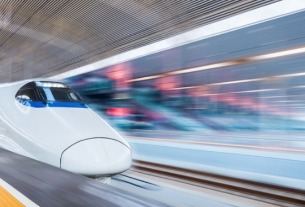Europe has seen a tremendous increase in the demand for rail travel following the growth of RENFE, the Spanish national rail carrier, and Eurostar. Rail is expected to wipe out demand from some LCC routes altogether. Apart from domestic travel, international rail travel continues to play a significant part in most of the European markets.
Similar trends have been seen in APAC countries like Taiwan and Japan, where geography favors rail for domestic travel. THRC, the high-speed rail that traverses western Taiwan, has changed travel patterns in the country and significantly impacted the domestic aviation industry. However, as travel trade is focused on outbound travel, the recent addition of highly profitable routes to China will promote LCC revenues, out of reach from rail competition.
In Japan, a relatively small country 73% covered by mountains, has less destination dispersion. Hence, most distances can be covered in less than 14 hours by express trains which run at a speed of more than 250 km/hr. This is a major reason why the LCC market has not been able to take off in Japan. JR-East, a privately owned company, is well positioned to perform and fend off competition by LCCs. In Japan, railways also have private bus companies providing the last mile connectivity which is so often missing elsewhere.
In 2009, China announced plans to build 35 high-speed train routes by 2012. Around 13,000 km of high-speed railways, capable of handling trains at between 200 and 350 km/hour will be developed. This will definitely have an impact on the LCC market in China which is already dormant. The high-speed direct rail connectivity between Shanghai and Beijing is expected to roll out this year and will add to the impact.
The prevailing global trend does not hold true in the case of India where both rail and LCCs can grow simultaneously. High-speed rail is not yet a viable option in India because the rail industry still relies on a 100 year old infrastructure. A new budget announced recently mentions a bullet train in the style of Japan, but this is still in discussions only. The Indian Railways monolith is a government-owned subsidiary with its rail network covering a total length of 63,140 kms and has seen tremendous traction in the past year in terms of bookings. This was due to the declining passenger demand for air travel especially the traditional airlines. In fact, the LCC bookings increased in the same year with increased market share of 49%. India is one country which is able to sustain both rail and LCC growth simultaneously due to lack of technological improvements in the rail segment and the growth in middle class population. Delving into the details of the new budget, PhoCusWright does not find reason to expect the current competitive balance to change. Here’s why.
India has a geographic area of 3.28 million sq kms of which 90% is accessible by road or train. This is huge in terms of destination dispersion. In the new budget, twelve new nonstop long distance trains connecting major cities to the capital were introduced.
1. Distance: If one looks at these routes, 70% are long distance, connecting the capital to the cities of Kolkata, Chennai, Mumbai, etc. which are more than 1000 kms in length. As these are major cities, business travel by rail might increase. However, this will not significantly impact leisure travel due to the uncomfortable conditions of such long journeys.
2. Time: The introduction of nonstop trains will cut down commuting time by a maximum of three hours. The trains are not express and travel at the usual speeds of about 90-100 km/hr. The new trains would cut a 14+ hour trip to 11 hours. For those travelling long distance by AC sleeper cars, it will be a minor difference. LCCs already took away demand for middle class long distance travel when they initially came to market by reducing travel time from 14 hours to three for 1.5 times the price. Customers that turn to LCCs for these long distances (including waitlisted rail passengers) will still cling to the LCCs for longer distances.
3. Increased capacity: The news routes will definitely enable more people to travel by rail and may take away demand from some LCC economy customers, The LCC business class traveller would be unaffected.
4. Availability: Due to a prevalence of sleeper car tickets, Indian rail is generally booked almost a month prior to departure; with nonstop trains, this time might now increase to more than a month. Because the ‘last-minute’ window will grow, more travellers may book LCC tickets instead, which can be booked on the same day. Deals for LCC tickets as low as US$36 will offset the increased cost of travelling by air.
5. Government: The rail budget is very socialistic and is unlikely to bring any significant market changes for rail or increased competition for LCCs.
PhoCusWright does not expect much to change in the Indian rail market from a demand perspective. However, LCCs might see an impact if they do not maintain a balanced price structure. With new airports coming online, the government levying additional airport taxes, fuel prices on an upward swing, and a recession to contend with, the impact might be heavier than expected for LCCs, but would definitely be a short term one.




